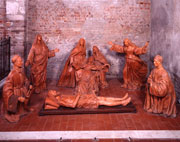
Pieve of San Martino
The art treasures of the Pieve
 Once inside the Pieve, you will notice that the right side still retains the medieval windows, the original columns and the remains of the round Palatine baptismal chapel dating back to the 5th century, which were found beneath the Pieve of the 11th century. On the contrary, the left side has undergone extensive rebuilding as it collapsed in the 18th century..
Once inside the Pieve, you will notice that the right side still retains the medieval windows, the original columns and the remains of the round Palatine baptismal chapel dating back to the 5th century, which were found beneath the Pieve of the 11th century. On the contrary, the left side has undergone extensive rebuilding as it collapsed in the 18th century..
Now let us explore the treasures that are housed in the Pieve ..... let us first look at the frescoes decorating the columns in the altar section. These were painted during different periods, with the oldest dating back at least 600 years (15th century). The fresco with Saint Martino, which gives the Church its name, is from the same era. Another fresco portrays the devotion of Saint Defendens, who is gripping a snake in his hands. He is known as the patron Saint for healing snake bites.
Also of interest, is the altar frontal painted in "fake marble" (scagliola) from the 17th century, depicting the Madonna of the Rosary.
Also take note of some of the capitals on top of the pillars in the southern nave, which were sculpted during the 11th century. One represents bunches of grapes, which are often mistaken for pine cones. Another capital found on a 15th century column has been redone to represent a dove and lamb, signifying the purity and simplicity of the spirit, and the sacrifice made by Christ. The scenes represented were used to convey lessons to believers during the Middle Ages.
The outstanding acoustics in the building enhance one of the Pieve's greatest treasures: an eighteenth century organ built by the Serrassi family, and restored in 1988. The Church is often used to record sacred and classical music concerts, thanks to its excellent acoustics.
A group of terracotta statues beside the entrance represent the Compassion of Christ. These Renaissance sculptures have been attributed to the renowned Cremonese artist, Agostino de Fondulis.
All'interno noterai che il lato destro conserva ancora le finestre, le colonne originali e i resti della cappella palatina battesimale a pianta circolare del V secolo, trovati sotto la Pieve dell’XI secolo, mentre il lato sinistro è stato restaurato più volte.
Ora conosciamo i tesori conservati nella Pieve ….. recandoci verso gli affreschi che decorano le colonne la zona dell'altare. Sono stati dipinti in vari periodi, i più antichi hanno almeno 600 anni (XV secolo) come l’affresco con San Martino che dà il nome alla chiesa. Un altro affresco riporta la figura devozionale di S. Defendente che stringe tra le mani una serpe. Il Santo è noto quale guaritore dai morsi di serpente.
Da notare è il paliotto dell’altare dipinto “a finto marmo” (scaiola) del XVII secolo raffigurante una Madonna del Rosario.
Da rilevare anche alcuni capitelli scolpiti dell’ XI secolo sopra i pilastri della navata meridionale. Uno raffigura dei grappoli d’uva, spesso scambiati per pigne. Un altro capitello è posato su una colonna del XV secolo, riusato e rappresenta una colomba ed un agnello per significare la purezza e semplicità dell’anima ed il sacrificio di Cristo. Nel Medioevo le scene figurate avevano uno scopo istruttivo per il popolo dei credenti.
L’eccellente acustica dell’edificio esalta poi uno dei maggiori tesori della Pieve: un organo settecentesco costruito dai Serrassi, restaurato filologicamente nel 1988. La Chiesa viene spesso utilizzata, per la sua ottima acustica, per le registrazioni di concerti di musica sacra e classica.
A fianco dell’ingresso un gruppo di statue in terracotta raffigura il Compianto di Cristo. L’opera rinascimentale è attribuita ad Agostino de Fondulis, grande artista cremasco.










